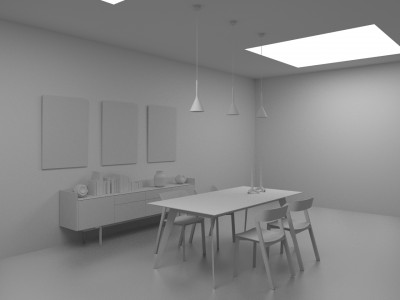Hi!
Okay,
Here's a scene lit with two area lights and irradiance caching turned on. Irradiance caching is a "smart" algorithm. It calculates the most important defining lighting and shadow points (simple explanation) and fills in the space in between with smooth, interpolated results. This is faster, but comes at the expense of some precision, mostly in the contact shadows.
Next is the same scene but lit with two luminous polygons instead of the area lights. Here the luminous polygons are visible, like two big rectangular lights at the ceiling. In a sense, this is more realistic than the previous render, because in the previous render the light came "from nowhere", where here you have a visible light source. Don't worry, we're going to hide these later!

This image is also done using irradiance caching. You'll see that you lose some shadow detail at the legs of the furniture on the floor, and on the wall behind the paintings.
Now we'll do the same render, but turning of irradiance caching. As I said above, irradiance caching was "smart", by sampling the light at the most relevant points, and smoothing out inbetween. When you turn off irradiance caching, we call this mode QMC or quasi-Monte-Carlo: this is a "stupid" or "brute force" method: the lighting is calculated for each individual pixel! This is much more precise or exact, but it is a) slower and b) give noisy results instead of smooth results. The more rays you fire to define the light and shadow, the less noise, but the longer the render takes. (for the record, the QMC method gives you the best results if you have the time, with LW lights or with LEM polygons). You'll see that the contact shadows of the furniture legs and painting are very good, but a bit noisy.

And lastly, let's hide the big LEM polygons and turn up the QMC quality. Hiding is done by going to object properties and unchecking "seen by camera" and "seen by rays" on the object - you need to put the LEM polys in a separate object. By the way, you can of course set different colours and strength of luminosity on different LEM polygons. Then you need to tell Kray that even though the LEMs are hidden, you still want to use them to light your scene, by going to Kray's "Misc" tab and checking "Unseen by rays casts light". In this render I've set the "Min Rays" and "Max Rays" on the Final Gather tab to 200 and 1200 to get less noise.
Lastly, here are my scene files!
http://we.tl/i4eQvql9eH
Good luck!
Thomas